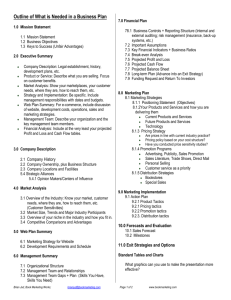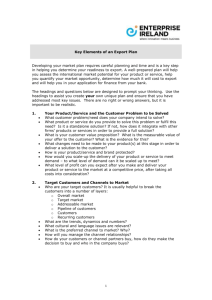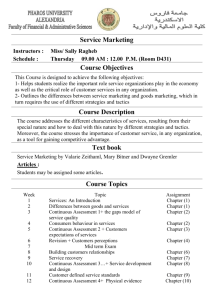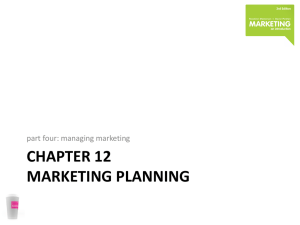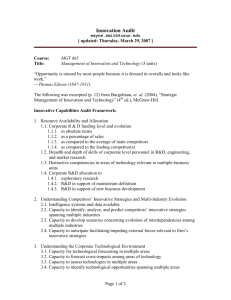Class Notes - Applicant seeking PhD in Marketing :: Monte Shaffer
advertisement
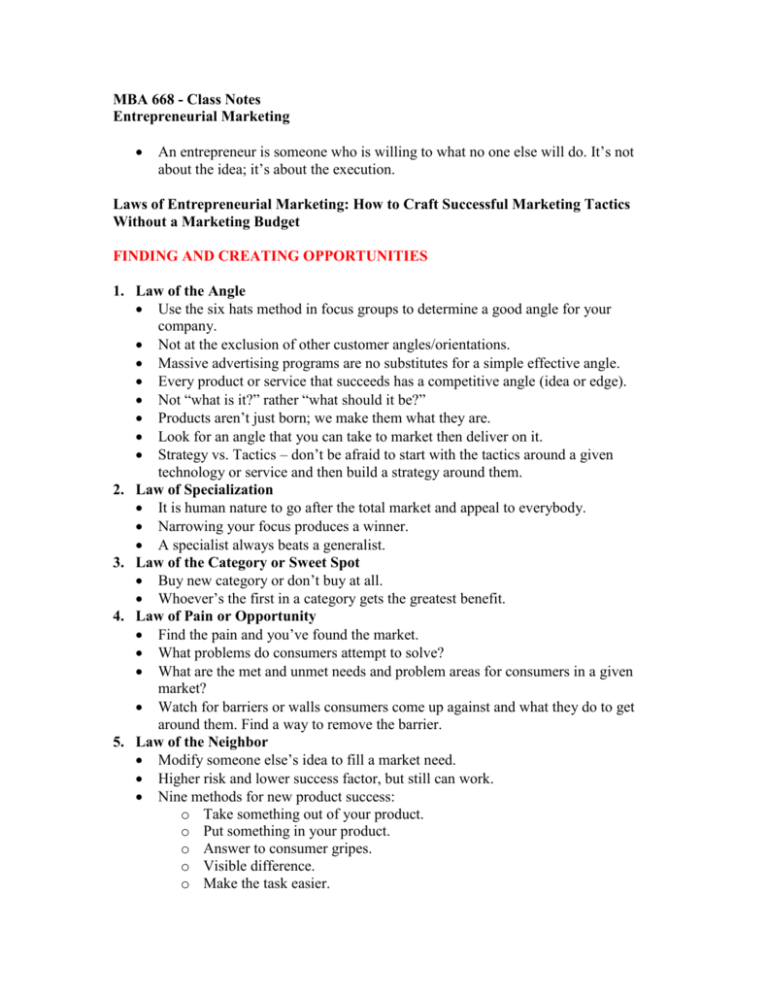
MBA 668 - Class Notes Entrepreneurial Marketing An entrepreneur is someone who is willing to what no one else will do. It’s not about the idea; it’s about the execution. Laws of Entrepreneurial Marketing: How to Craft Successful Marketing Tactics Without a Marketing Budget FINDING AND CREATING OPPORTUNITIES 1. Law of the Angle Use the six hats method in focus groups to determine a good angle for your company. Not at the exclusion of other customer angles/orientations. Massive advertising programs are no substitutes for a simple effective angle. Every product or service that succeeds has a competitive angle (idea or edge). Not “what is it?” rather “what should it be?” Products aren’t just born; we make them what they are. Look for an angle that you can take to market then deliver on it. Strategy vs. Tactics – don’t be afraid to start with the tactics around a given technology or service and then build a strategy around them. 2. Law of Specialization It is human nature to go after the total market and appeal to everybody. Narrowing your focus produces a winner. A specialist always beats a generalist. 3. Law of the Category or Sweet Spot Buy new category or don’t buy at all. Whoever’s the first in a category gets the greatest benefit. 4. Law of Pain or Opportunity Find the pain and you’ve found the market. What problems do consumers attempt to solve? What are the met and unmet needs and problem areas for consumers in a given market? Watch for barriers or walls consumers come up against and what they do to get around them. Find a way to remove the barrier. 5. Law of the Neighbor Modify someone else’s idea to fill a market need. Higher risk and lower success factor, but still can work. Nine methods for new product success: o Take something out of your product. o Put something in your product. o Answer to consumer gripes. o Visible difference. o Make the task easier. o o o o Use products in a new way. Product substitutability. Don’t be literal, be creative. Look overseas. THE MULTIPLIER EFFECT (Most critical to success) 6. Law of Horses The key to real success in life is to believe in someone else. Find a horse you can ride to the bank. Increase your speed to market. You can get anything in life you want if you will just help enough other people get what they want. –Zig Ziglar It’s not what you know, it’s who you know! I don’t have much money, how should we feed the horses? o Power o Recognition o Credibility o Stock—increase wealth o Everyone likes being associated with a winner If you don’t have a powerful reputation, surround yourself with many people who do. 7. Law of the Spider Web You can’t make yourself successful; only other people can do that. Advisory board members should not be people who have simply done things, but people who can get things done. Credible members give your company credibility as well. Leverage members’ experience and connections to create your network, attract investors, and craft a successful image for your company. Make your advisory board the “who’s who” of the industry. “Experience counts – and it doesn’t have to be your own.” Network: o Gurus o Politicians o Advisory Board* o Founders o Partners o Anchor Customer o Board Members o Key Suppliers 8. Law of the Puffer Fish Perception is reality Non-permanent change in how the startup presents itself such that others looking from the outside in will see the company as much larger than it is. Implementing the principle of the puffer fish – when your path crosses that of a customer, a funding source, a competitor, or anyone else – will allow the firm to appear larger and more capable than it actually is. Customers want to see a stable company. Advisors want to help viable businesses. Suppliers want to partner with the industry standard. Partners want to team-up with a company that would help their reputation. Especially important for startups trying to reach critical mass. 9. Law of the Benefactors Question: Who benefits if I succeed? If I win who else wins? Customers, companies, etc The most powerful thought in the world is to seek an answer to a well thought out question. GKR 10. Law of the Anchor With an anchor on board you are bound to go places All about building relationships A strong partner Give your product away to get an anchor 11. Law of Energy Work = Force * Distance What lies at the heart of an entrepreneurship is to do the things today that other people simply won't do. Successful entrepreneurs have the persona and a strong passion to succeed Give 110% working long hours, including weekends for long periods of time. A tale of action 12. Law of Beta Gold Mine Beta customers are like veins of gold, they are the first customers that provide needed cash Use Beta customers to fund your fix cost and R&D Customizing it to that client You have the technology, but not a product. Once you customize it then you have a product for the entire industry CUSTOMERS AND PARTNERS 13. Law of the Chase Chase customers not competitors. Do the opposite of what everyone else is doing and you just might find a successful new tactic. When everyone is making one type of thing, try making the opposite. 14. Law of the Channel There is only one thing worse than one salesperson…no salesperson. Find a channel, find a sales-force! You don’t need your own sales force! Strong channels make winners. Finding the right channel to distribute your product is everything. The million dollar question – how are you going to reach your customer? 15. Law of Courtship o Get the “I do!” o Your first customers are not your customers. o Court the love group – create loyalty through engagement. o Commitment escalates as the relationship progresses. o Find that love group…nurture them…build the relationship…get them for the long haul. o Start early with anchor or beta customers: Use customer’s input and advice. Ask some customers to be a part of customer advocacy council or permanent focus group. o Ask for feedback: Don’t rely on occasional focus groups or surveys. Make sure the customer can give feedback at all points along the way. 16. Law of the Love Fest Let your own customers sell for you! Invite your customers (even pay them to come) to a conference and have them convince/attract new customers. Their independent voice will make a difference. 17. Law of Producing Heroes o It is human nature to think about how smart we are, how great our product is and that our company is a winner. However, successful start-ups realize that they win by making their customers, and employees, heroes. o How do I make my customers heroes? Give them the credit. Remove yourself from the equation. o Gauge yourself on how strong your customers feel that they are the champions, solver of the great problems facing companies. 18. Law of Exceeding Expectations Companies today pride themselves in producing products where performance = expectations. Successful entrepreneurs delight their customers where performance > expectations. Under commit and over deliver! Entrepreneurs generally get so excited that they over commit. If your product is in the sweet spot, you won’t have to. 19. Law of Marketing Tactics (Focus, Laser Beam) Execution: it is not about money, not about strategy. It is about tactics! The tactics that make you profitable today are supreme, not an overriding strategy that looms somewhere in the distance. What can you do to have an impact right today? Dominate the situation. Customers buy products and services for specific usage situations. Capitalize on and dominate these situations! 20. Law of Faster, Better, Cheaper Make a small change to a product or service. Evolve the existing business model in a profitable way by offering a better, faster, cheaper alternative. 21. Law of the Closer Use your selling skills to get an order or complete a deal. Beg for the order if you have to. 22. Law of the Situation Focus is the key. Target a specific segment and usage situation. Don’t try to be all things to everybody. When you are all things to everybody, you become nothing to nobody. Situational usage is supreme. Dominate a usage situation. 23. Law of Publicity (Marketing Events) A venture is launched on the wings of publicity, not advertising! Publicity provides instant credibility, often self-multiplies, and has more impact than advertising, and is usually cheap. Marketing events create publicity. 24. Law of Free/Addiction Hook them today with ‘free,’ start charging tomorrow. Corollary: free attracts non-target customers. Be careful not to drown your company in free. If you give something away, people won’t value it. 25. Law of (Stop the) Warm Fuzzies: Action is Supreme Don’t confuse action with results. Warm fuzzies don’t put money in your pocket. Be concerned if everyone in a company has warm fuzzies – people are not concerned immediately with making money because feedback is so positive generally…a big deal is “on the way”! Don’t high-five until contracts are signed and money is coming in. 26. Law of Augmentation Look for ways to augment the core product. This may turn out to be a significant revenue source. 27. Law of the Guarantee Talk the walk and walk the walk. “They are so confident that there is no risk. I’d be crazy not to buy it.” Lower the customer risk to a point that they have nothing to lose and everything to gain. 28. Law of Rabbits and Elephants To survive, companies must kill rabbits along the way before they kill an elephant. 29. Law of Love, Swing, Hate 30. Law of Leveraging Deals Use fear of not acting and loss of opportunity as an incentive to take action with suppliers, partners, and customers. Make them feel like they will be missing something important by dropping names of their competitors that you are already working / meeting with. The dating effect. 31. Law of Incentive Pricing Price the product where value > price. Wow factor. Assumes a sweet spot (differentiation). Use your pricing strategy as another promotional incentive to sell product. Don’t be greedy when you are starting out – first get to profitability (cash is king), then worry about market share. Traction and penetration are critical to cash flow. High Knowledge of Competitors Low Knowledge of Customers Low High Parity Pricing – based on Incentive Pricing – where value competitors. is greater than price. Blue Ocean – the golden goose. Market Pricing – costBe careful not to price too high based pricing. (if you have few competitors), or they will enter. 32. Law of Evolution Faster, better, cheaper – all three make a great winner. 33. Law of Gut Over Matter You need a healthy balance of gut feelings and research. Don’t get caught in analysis paralysis. Be somewhere in the middle. Never assume that a market exists for your product. 34. Law of the Drummer Boy Having someone else beat your drum is always better than you as a company pounding on the drum. No matter how creatively you beat your drum, people generally know the sound is coming from you. Bad idea. 35. Law of Scarcity (Thrift) Only spend money to make money. Only spend when absolutely necessary. If a dollar can’t be tied to a dollar earned, then forget it! ENTREPRENEURIAL LEADERSHIP TRAITS AND SKILLS 36. Law of Proverbs Pride Goethe before destruction. Egos build your business, but it is the enemy of successful entrepreneurship. Always think like the customer thinks – think like a fish! 37. Law of Change Be confident, but always be willing to compromise to make deals. Be willing to give in to get a lot. 38. Law of Failing Safely Don’t bet your success on one marketing tactic. Learn to fail safely. Always have a backup plan and be willing to explore alternatives, change courses, and evolve plans on a moment’s notice. Inevitably, products, processes, strategies, and tactics will have to evolve. Be adaptable. Learn as you go. 39. Law of the Magnet Successful entrepreneurs have the ability to attract (for the short-term) talented people. In short, the people of the bus are always changing to meet the needs of the company. Successful entrepreneurs are a people magnet. 40. Law of the Cult Weed out the non-believers so that only the zealots remain. There is only room for believers in the company. Non-believers should be excommunicated. 41. Law of Manure Equity is like manure: you have to spread it around! Not too thick. Not too thin. 42. Law of Archie Bunker Keeping it “all in the family” is asking for trouble. There is no equal effort. Base stock on performance incentives. 43. Law of Too Much or Too Little Two reasons companies fail is that they receive too much or too little capital to succeed. Receiving too much money does not focus the company on succeeding today. The Tipping Point It takes research (understanding your customer) and often only minor tweaking to tip a good idea into a great idea. Sesame Street – make it so people “can’t take their eye off it.” Epidemics are created by our environment. Groups play a critical role in the spread of epidemics: o Rule of 150 o Small, informal groups = peer pressure o Peer pressure > boss o Peer pressure to perform better is more effective than top-down method. People are overwhelmed with information. Many have developed immunity to traditional forms of marketing. To cure information immunity, a product’s message must stick to Mavens, Connectors, and Salesmen. Entrepreneurial Marketing vs. Traditional Corporate Marketing (4 P’s): Form strategic partnerships “Build, recruit, develop” – terms that don’t mean anything to companies with no budget (or time). Perceived value > perceived cost Potential for synergies Complicated Entangled Not all partnerships are equal – you are going to be the weaker partner Limiting The Art of the Start At the end of the day, entrepreneurship and selling is about relationships. People will buy from you if they just like you better. You have to believe in your product in order for people to believe you. Don’t take dumb money – money from people who won’t contribute to your effort. Take smart money – money from people who are capable and passionate about your effort. Recruit evangelists. Starting a company is like starting a cult. The art of rainmaking Rob Jepson, Primary Intelligence – Marketing for Entrepreneurial Firms It takes a whole different set of skills to get people to take a bet on you (and buy) as an entrepreneurial company versus established company. Law #1: Don’t be a market maker (category creator): o Instead, fill an existing market need. o Why? Clear and compelling message. Easier to get customer’s budget. Less marketing $$ required to acquire customers. Many young companies go broke trying to educate the market. Be able to answer the “so what?” question in a sentence or two. If you can’t, go back and rethink your product/service/business. o Messages that win (if you’re selling something that’s important to people): Increase revenues. Decrease costs. Faster, cheaper better. o You can only create value by: Solving a problem that people care about. Producing a result that people will love to see. *The market must tell you this by their own mouth. o Class market maker pitfalls: Law of Focus: Chase any deal. All things to all people – you don’t stand for something. “Pretty-Baby” Syndrome: Won’t let anyone call their baby ugly. So enamored with products, benefits, or feature sets that a true understanding of a REAL market need is missed. Running the Wrong Race: Always chase customers. Tailor what you offer specifically to their needs: o You will develop better offerings faster than your competitors. o If you don’t have a target on your back, you’re doing something wrong. Don’t chase competitors: o What if your competitors are out of alignment with what the market wants? o Understand your competition, to be sure, just don’t chase them. Core Problem: Lack of intelligence (market intelligence) Customer alignment o #1 challenge for all companies…mature or entrepreneurial Law #2: Fight the Right Battle: o What is marketing a battle for? The MIND – the doorway to the wallet. It’s not about the money – how much money you have for your marketing budget. Frequency x Reach doesn’t mean anything in entrepreneurial marketing. It’s not about the strategy – strategies typically exclude selling, which is the most important thing (nothing happens in business until you sell something). “If you build it, they will come” – jack squat! You have to go out and get customers. It is about the tactics: What can you do to have impact right away? Don’t say, ‘we’ll be cash flow positive in a few years’! What are things people do to win the mind? Choose your position: o Positioning drives tactics. o Only two defensible positions (anywhere in between and you’re in No Man’s Land): Value Providers, they define themselves by: What they say. What they cost. Products they sell. Differentiated Providers: What they do. What others say. Problems they solve. Understand positioning goal clearly. Positioning drives tactics. Classic marketing pitfalls: o Big budget = big success. o Don’t confuse strategy for a tactical plan. o Don’t confuse activity for accomplishment. Law #3: Focus on the “Holy Grail”: o The most important asset to a young company: The anchor customer o Definition of an anchor: Early adopter. Reputable, with name brand if possible. Strong reference – must be willing to let you use their name. Patient. o Know your customer’s pain. o Price aggressively. Create a situation where they have nothing to lose. Make sure the anchor is a meaningful reference source. Worry more about traction and less about profitability. Don’t give it away for free – they won’t want to pay for it ever! Having skin in the game will drive the proper business relationship and expectations. o The anchor customer is the hardest to get. Law #4: Perception is Reality: o If you look big, then you are big. o Corollary: message can’t be laughable. o You can’t beat your own drum too loudly too early: Early messages are best delivered by: Anchor customers Partners Advisory board / board member Investor Law #5: Never Forget Job #1: o Job #1: move the sales needle. o We’re in the deal-making business: Not the feel-good business. Sell, sell, sell. All other functions support sales o Classic pitfall: confusing objections for objectives. Summary: o Fill a critical need / achieve alignment early. Shorter sales cycle. Less expensive to educate market. Easier to get attention of influencers. o Focus on deal-making: Focusing on anything else can kill you. o Have a clear positioning goal. A-List o Write your own PR – send it to the winners, losers, and those not invited to the dance! o Profiles of publicly-announced high-profile strategic decisions: Big name Big $ Big impact o Deals are flagged PI or suggested by recipients. o Operations evaluates, write analysis, and publishes o Distribution o Frequency: 3-4 profiles per month. o Find creative ways to use your strengths to get important people to talk to you. You don’t have to spend a dime! Robert Stevens – IT Entrepreneur rob@writeexpress.com RE: BYU MBA Innovator’s Dilemma – most innovation takes place inside the firm, but is shot down by management because “our customers aren’t asking for this…” Google – instituted pay per click advertising once they had established an enormous consumer search base. Create a business: o Topics: Pet rocks o Competitor Analysis: Google the phrase. Look for search string in the web address. Name your website exactly what people will be searching: petrocks.com Name a folder the same as the search string: xxx.com/petrocks.html What is the magic formula for ranking web sites in an online search? Go to website and View Source code of website: How many times does the search string appear on the website “above the fold” (like a newspaper)? Should appear 4+ times above the fold. <body> <h1> through <h4> are headlines. Keyword phrases in the h1 tag will return better than h4. Make the web link names on your website match the keywords. That will increase your chances of coming up higher in someone’s search. o Summary: Repeat phrase above the fold at least 4 times. In header tags. In paragraph text. In meta name keyword search (don’t stuff too full of keywords – Google will ding you!). Visit competitor sites. Make lists: Captivating headlines. Sales copy. Rank the site yourself. Save graphics you like. Make an outline of important search terms, then build a page for every keyword phrase. Give this outline to the programmers and writers – direct their creativity. Remember that any page within your website could be the consumer’s landing page. Leave breadcrumbs on every page so consumers can get to the higher levels of the website hierarchy. Alexa: rank the website and see traffic details. Netcraft.com: Web server archive – how many websites there are out there. DOS: ping lds.org gives you the IP address http://198.12.123.12 will give you the website. The point is that you can take the #1 search return spot for any item you want to sell online. Inventory.overture.com: counts # of times any term was searched for on the web. Overture represents about 1/3 of the clicks on the web, so multiply their number by 3 to get a rough estimate of total clicks. Content.overture.com: View Bids Tool – find out how much your competitors bidding per click. Underbid your competitor by $0.01 to drive up their advertising costs. Don’t get burned! ROI Calculator – based on total monthly clicks, average cost per click, conversion rate (0-2%), average profit per conversion. Wordtracker.com: free keyword report (get free trial…forever). Adwords.google.com: recommends different words you might want to consider advertising with, relative to a keyword you enter. Sign up as a Google AdSense partner and get profit sharing for directing people to other websites. They will pay you for directing traffic to their sites! You can also do this with Overture. Show advertisement links on your website just like a Google page. People will use you as a portal! If you become an AdSense partner, Google will list you on Google and you will get more hits. Search Engine Visibility – great book Average cost per click: $.40! Archive.org: lets you look at older versions of websites. Cj.com: What kind of advertising works for all your competitors and potential partners (affiliate marketing). Sign up as a publisher and have advertisers sign up to be your affiliate marketers/partners – others will list you on their website to profit share on traffic they direct to you. o Tips: Cheap way of writing text for website: Go to government sites and grab the text and call it your own. Biggest publisher in the world but they don’t copyright their text. Books: Don’t Make Me Think, 22 Immutable Laws of Marketing, Guerilla Marketing, The E-Myth Core Question to Entrepreneurs/Companies: What are you selling? Sell the core – get focused (focus groups) on an angle Don’t sell tangible attributes, but understand them. The real money is in the augmented tactics, products, services. Augmented reinforces the core. After you’ve figured out the core/tangible/augmented thing, then start into the laws of entrepreneurial marketing. Principles of Social Networks: 1. Networks are invisible. 2. People link with others who are similar. 3. Similar people form clusters. 4. Buzz spreads through common nodes. 5. Information gets trapped in clusters. 6. Network bubs and connectors create shortcuts. 7. We talk to those around us. 8. Weak ties are surprisingly strong. 9. The Net nurtures weak ties. Mike’s Notes (3/25/05) Opportunities Law of the Angle Law of the Specialization Law of the Neighbor Law of the Category Law of the Pain Multiplier Effect Law of Horses Law of the Spider Web Law of the Puffer fish Law of Energy Law of Benefactors Law of Beta gold mines Law of the Anchor Customers and Partners Law of the Chase Law of Channel advantage Law of the Courtship Law of the Love fest Law of Producing heroes Law of Exceeding expectations Marketing Tactics Law of Marketing tactics Law of the Laser beam Law of Faster, better, cheaper Law of the Situation Law of Thrift Law of Publicity Law of Free/addiction Law of the Warm Fuzzies – find ways to make money, urgency, don’t be complacent Law of Augmentation Law of the Guarantee Law of Rabbits and elephants Law of the Love, swing, hate Law of Leveraging deals – make them think you have a lot of options, always leverage passion Law of Incentive pricing Law of Gut over matter Law of the Drummer boy Law of the Closer The dark side of entrepreneurship We wants it o Personalities that were responsible for their own company failures, some have a need for control and can be hard headed and make bad decisions against better advice. o Very defensive, sense of distrust, desire for applause – pride goeth before the fall – a lot of faculty don’t like to work with entrepreneurs because their worlds collide, success is money versus success equals education Article – modern day good Samaritan Issue it brings up is who you are shows forth when your company is under stress. Point is entrepreneurs are so goal driven that everything around us becomes oblivious. Sometimes not as sensitive as you should have been. Need a work family balance. Consulting exercise with Weight Wars Do two sites, weight support group or weight wars Somehow partner with “the biggest loser” Better web optimization – know conversion rates, who is visiting the site and who is signing up, Do the disc jockeys Get fitness clubs to adopt as software to help them track the weight loss in their gym, maybe modify a little for each, get long term contracts which gets long term revenue. Get them to sponsor marketing events. Consulting exercise with homeplans.com, coolhouseplan.com, frankbetz.com (700,000 of this site per month), realtor.com, envisiondesigngroup (virtual homes), internest.com (gives cash back), builderfusion.com (offering 4% of their company), utahparade.com,
